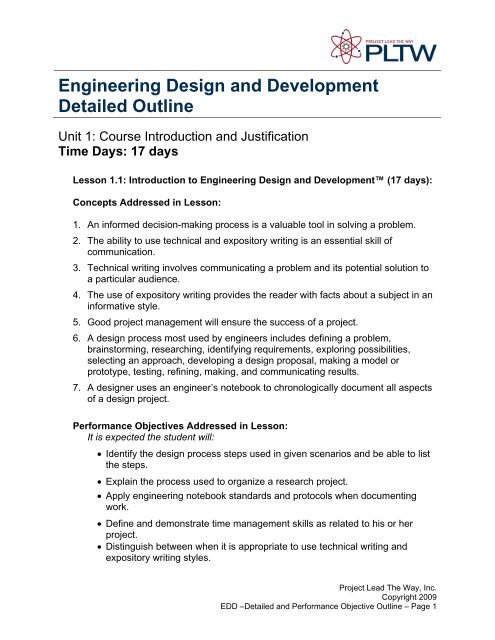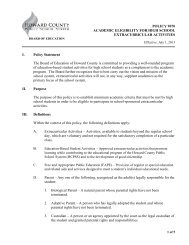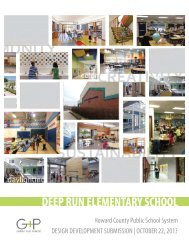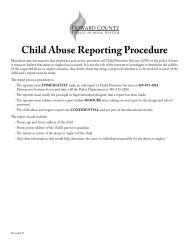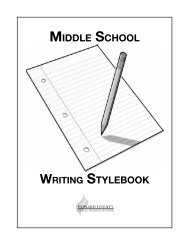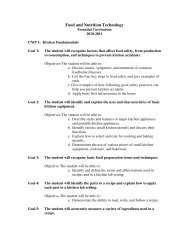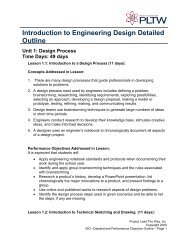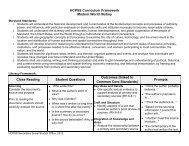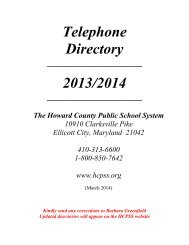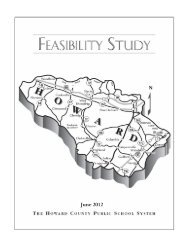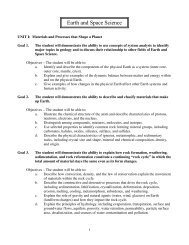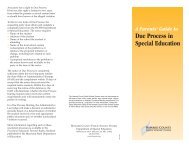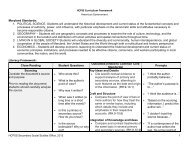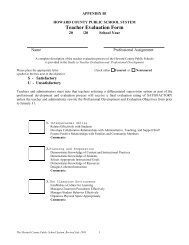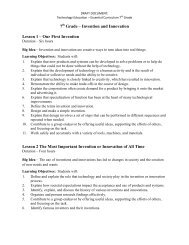Engineering Design and Development Detailed Outline
Engineering Design and Development Detailed Outline
Engineering Design and Development Detailed Outline
You also want an ePaper? Increase the reach of your titles
YUMPU automatically turns print PDFs into web optimized ePapers that Google loves.
<strong>Engineering</strong> <strong>Design</strong> <strong>and</strong> <strong>Development</strong><br />
<strong>Detailed</strong> <strong>Outline</strong><br />
Unit 1: Course Introduction <strong>and</strong> Justification<br />
Time Days: 17 days<br />
Lesson 1.1: Introduction to <strong>Engineering</strong> <strong>Design</strong> <strong>and</strong> <strong>Development</strong> (17 days):<br />
Concepts Addressed in Lesson:<br />
1. An informed decision-making process is a valuable tool in solving a problem.<br />
2. The ability to use technical <strong>and</strong> expository writing is an essential skill of<br />
communication.<br />
3. Technical writing involves communicating a problem <strong>and</strong> its potential solution to<br />
a particular audience.<br />
4. The use of expository writing provides the reader with facts about a subject in an<br />
informative style.<br />
5. Good project management will ensure the success of a project.<br />
6. A design process most used by engineers includes defining a problem,<br />
brainstorming, researching, identifying requirements, exploring possibilities,<br />
selecting an approach, developing a design proposal, making a model or<br />
prototype, testing, refining, making, <strong>and</strong> communicating results.<br />
7. A designer uses an engineer’s notebook to chronologically document all aspects<br />
of a design project.<br />
Performance Objectives Addressed in Lesson:<br />
It is expected the student will:<br />
• Identify the design process steps used in given scenarios <strong>and</strong> be able to list<br />
the steps.<br />
• Explain the process used to organize a research project.<br />
• Apply engineering notebook st<strong>and</strong>ards <strong>and</strong> protocols when documenting<br />
work.<br />
• Define <strong>and</strong> demonstrate time management skills as related to his or her<br />
project.<br />
• Distinguish between when it is appropriate to use technical writing <strong>and</strong><br />
expository writing styles.<br />
Project Lead The Way, Inc.<br />
Copyright 2009<br />
EDD –<strong>Detailed</strong> <strong>and</strong> Performance Objective <strong>Outline</strong> – Page 1
Unit 2: Problem Identification<br />
Time Days: 30 days<br />
Lesson 2.1: Introduction to Problem Statement (9 days):<br />
Concepts Addressed in Lesson:<br />
1. Brainstorming is an effective technique used to generate problem statements to<br />
identified problems.<br />
2. Writing a concise problem statement is the foundation in solving problems.<br />
3. An accurately written problem statement aids in determining if the result of the<br />
engineering design <strong>and</strong> development process has solved the identified problem.<br />
Performance Objectives Addressed in Lesson:<br />
It is expected the student will:<br />
• Brainstorm problem statements for unique innovations or inventions.<br />
• Write concise problem statements using technical writing skills.<br />
• Document research that justifies the problem statement for the engineering<br />
design <strong>and</strong> development project.<br />
Lesson 2.2: Verify <strong>and</strong> Justify the Problem (21 days):<br />
Concepts Addressed in Lesson:<br />
1. An accurately written problem statement identifies a need <strong>and</strong> guides the design<br />
process that will be used in engineering design problems.<br />
2. Experts are professionals that guide the research needed for accurate<br />
justification <strong>and</strong> solutions to design problems.<br />
Performance Objectives Addressed in Lesson:<br />
It is expected the student will:<br />
• Be able to speak to experts appropriately.<br />
• Ask valid questions that will be used to further the student’s knowledge of<br />
the problem statement.<br />
• Write a problem statement as well as verify <strong>and</strong> justify the statement.<br />
• Document the project process in an engineering notebook.<br />
• Use strong oral <strong>and</strong> written skills to communicate with experts.<br />
Unit 3: Research<br />
Time Days: 15 days<br />
Project Lead The Way, Inc.<br />
Copyright 2009<br />
EDD –<strong>Detailed</strong> <strong>and</strong> Performance Objective <strong>Outline</strong> – Page 2
Lesson 3.1: Research <strong>and</strong> <strong>Development</strong> (3 days):<br />
Concepts Addressed in Lesson:<br />
1. Research refers to the advancement of knowledge <strong>and</strong> development refers to the<br />
application of knowledge.<br />
2. Market research aids business <strong>and</strong> industry in making better decisions about the<br />
development <strong>and</strong> marketing of new products.<br />
Performance Objectives Addressed in Lesson:<br />
It is expected that students will:<br />
• Study cases (articles supplied by the teacher) regarding research <strong>and</strong><br />
development <strong>and</strong> its impact on the invention <strong>and</strong> innovation of products,<br />
processes, or services.<br />
• Create market research to investigate <strong>and</strong> determine the merit of their<br />
solution.<br />
• Self-assess their performance <strong>and</strong> research based on the goals for<br />
developing a solution to a problem.<br />
Lesson 3.2: Investigate Current <strong>and</strong> Past Solutions (6 days):<br />
Concepts Addressed in Lesson:<br />
1. A patent is a legally binding agreement between an inventor, owner, <strong>and</strong> the<br />
people of the United States that grants the exclusive right to produce <strong>and</strong> sell an<br />
invention or innovation for a certain length of time.<br />
2. Securing a patent involves a series of steps that must be followed.<br />
3. Research is used to investigate what solutions exist to a technical problem <strong>and</strong> if<br />
an innovation or new invention is warranted.<br />
Performance Objectives Addressed in Lesson:<br />
It is expected the student will:<br />
• Use a list of specifications <strong>and</strong> constraints identified in a decision matrix to<br />
develop a list of alternative solutions to the stated problem.<br />
• Research <strong>and</strong> identify patents related to their identified problem.<br />
• Conduct research to investigate <strong>and</strong> determine the merit of his or her<br />
alternative solution based on past solutions to the problem.<br />
• Explain the feasibility of his or her solution based on his or her research.<br />
• Develop research strategies for his or her solution, including the use of<br />
surveys, phone interviews, <strong>and</strong> personal contact with experts related to the<br />
field of his or her technical problem.<br />
• Create a matrix table to analyze the data found from the patent research.<br />
Lesson 3.3: Invent or Innovate (6 days):<br />
Project Lead The Way, Inc.<br />
Copyright 2009<br />
EDD –<strong>Detailed</strong> <strong>and</strong> Performance Objective <strong>Outline</strong> – Page 3
Concepts Addressed in Lesson:<br />
1. Engineers design solutions to technical problems that may be an invention,<br />
something new, or they may be an innovation, a modification of an already<br />
existing solution.<br />
2. Inventions <strong>and</strong> innovations are the results of specific, goal-directed research.<br />
3. Creative thinking <strong>and</strong> economic <strong>and</strong> cultural influences shape the development of<br />
solutions to technical problems.<br />
4. The use of assessment techniques, such as trend analysis provides information<br />
to determine if a solution should be pursued to design <strong>and</strong> development.<br />
Performance Objectives Addressed in Lesson:<br />
It is expected the student will:<br />
• Conduct research to identify the difference between innovation <strong>and</strong><br />
invention.<br />
• Write a fictional scenario for an innovation of interest.<br />
• Discuss the pros <strong>and</strong> cons of a decision matrix.<br />
• Conduct research <strong>and</strong> perform a trend analysis on a technical problem.<br />
• Sketch one invention <strong>and</strong> one innovation related to the technical problem.<br />
Unit 4: Decision Process<br />
Time Days: 8 days<br />
Lesson 4.1: Defining Product Specifications (8 days):<br />
Concepts Addressed in Lesson:<br />
1. Specifications for a design solution enhance creativity by identifying the criteria<br />
<strong>and</strong> constraints of the design process.<br />
2. Engineers use a decision matrix to evaluate the preliminary design solution by<br />
implementing mulitple parameters.<br />
3. The use of optimization improves the final design solution by justifying the<br />
specifications applied.<br />
Performance Objectives Addressed in Lesson:<br />
It is expected students will:<br />
• Create a description of the product specifications for the design solution.<br />
• Objectively evaluate proposed design solutions using specific criteria.<br />
• Select the best design solution option using a decision matrix.<br />
• Graphically represent the results of the design solution evaluation.<br />
Unit 5: <strong>Design</strong><br />
Project Lead The Way, Inc.<br />
Copyright 2009<br />
EDD –<strong>Detailed</strong> <strong>and</strong> Performance Objective <strong>Outline</strong> – Page 4
Time Days: 20 days<br />
Lesson 5.1: Sketching <strong>and</strong> Technical Drawings (20 days):<br />
Concepts Addressed in Lesson:<br />
1. The use of symbols <strong>and</strong> drawings promotes clear communication of a design<br />
solution.<br />
2. Drawings <strong>and</strong> sketches are used to organize, record, <strong>and</strong> communicate ideas to<br />
experts.<br />
3. Engineers use working drawings to show all the information needed to make a<br />
single part, subassembly, or a complete design solution.<br />
4. Technical drawings are used to evaluate design solutions for any necessary<br />
refinements.<br />
Performance Objectives Addressed in Lesson:<br />
It is expected students will:<br />
• Sketch all parts of their design solution including an isometric view of the<br />
assembled product.<br />
• Create a set of working drawings for their design solution.<br />
• Interpret <strong>and</strong> apply the feedback they receive from experts to improve their<br />
design solution.<br />
• Refine their design solution, if necessary, based upon expert feedback.<br />
• Document the project’s progress in their engineering notebooks.<br />
Unit 6: Build<br />
Time Days: 35 days<br />
Lesson 6.1: Building a Prototype (35 days):<br />
Concepts Addressed in Lesson:<br />
1. The use of tool machine safety allows engineers to prevent accidents during the<br />
construction of the prototype.<br />
2. Engineers write step-by-step instructions for the prototype assembly to guide the<br />
fabrication of the design solution.<br />
3. Availability of materials <strong>and</strong> equipment is determined by using a materials <strong>and</strong><br />
cost analysis during the prototyping phase of a project.<br />
4. Prototyping provides the engineer with a scaled working model of the design<br />
solution.<br />
Performance Objectives Addressed in Lesson:<br />
It is expected students will:<br />
Project Lead The Way, Inc.<br />
Copyright 2009<br />
EDD –<strong>Detailed</strong> <strong>and</strong> Performance Objective <strong>Outline</strong> – Page 5
• Identify safe practices for the use of tools <strong>and</strong> equipment.<br />
• Create a detailed set of instructions for producing a testable prototype<br />
based on the information gained through their research.<br />
• Identify methods <strong>and</strong> sources for obtaining materials <strong>and</strong> supplies.<br />
• Compile a materials list that includes vendors <strong>and</strong> cost for all necessary<br />
materials <strong>and</strong> equipment to build their prototype.<br />
• Write a step-by-step procedure for the assembly of their prototype.<br />
• Build a working prototype that can be tested.<br />
Unit 7: Test<br />
Time Days: 24 days<br />
Lesson 7.1: Test Method (6 days):<br />
Concepts Addressed in Lesson:<br />
1. Specific criteria for success or failure of a test must be determined before testing<br />
commences.<br />
2. Prototype testing is a controlled procedure that is used to evaluate a specific<br />
aspect of a design solution.<br />
3. The results of prototype testing are used to refine the design <strong>and</strong> to improve the<br />
design solution.<br />
Performance Objectives Addressed in Lesson:<br />
It is expected students will:<br />
• Select <strong>and</strong> describe a valid testing method that will be used to accurately<br />
evaluate their design solution’s ability to solve their problem.<br />
• Prepare a description of the testing method that will be used to valid the<br />
designed solution.<br />
• Create a valid justification for the selected testing method.<br />
• Devise a list of testing criteria that will be used to evaluate the success or<br />
failure of their prototype testing<br />
• Identify, define, <strong>and</strong> implement needed modifications to their testing method<br />
based on expert feedback <strong>and</strong> their ongoing research.<br />
• Document their project’s progress in their engineer’s notebook.<br />
Lesson 7.2: Test <strong>Design</strong>ed Solution (18 days):<br />
Concepts Addressed in Lesson:<br />
1. Engineers write a detailed description of the testing procedure to ensure the<br />
testing of the design solution is valid.<br />
2. Evaluation of the test results allows engineers to determine if the test is accurate<br />
<strong>and</strong> repeatable.<br />
Project Lead The Way, Inc.<br />
Copyright 2009<br />
EDD –<strong>Detailed</strong> <strong>and</strong> Performance Objective <strong>Outline</strong> – Page 6
Performance Objectives Addressed in Lesson:<br />
It is expected students will:<br />
• Create a detailed set of instructions for testing the prototype that will be<br />
valid, repeatable, <strong>and</strong> reliable.<br />
• Apply the appropriate statistical analysis tools to the test results to ensure<br />
validity.<br />
• Identify, define, <strong>and</strong> implement necessary modifications to their design<br />
based upon their test results.<br />
• Identify how their solution has removed obsolescence of the original<br />
product, if appropriate.<br />
• Evaluate <strong>and</strong> explain the effectiveness of their design at solving the<br />
problem they have defined.<br />
• Document the test results <strong>and</strong> project progress in their engineering<br />
notebooks.<br />
Unit 8: Presentation<br />
Time Days: 26 days<br />
Lesson 8.1: Project Documentation (17 days):<br />
Concepts Addressed in Lesson:<br />
1. The use of PowerPoint ® allows engineers to present visual aids <strong>and</strong> project<br />
information in a professional manner.<br />
2. Engineers use a technical report to provide thorough communication of all<br />
aspects of a design solution.<br />
3. Various media formats are chosen to effectively communicate the design solution<br />
process to a target audience.<br />
Performance Objectives Addressed in Lesson:<br />
It is expected students will:<br />
• Gather data <strong>and</strong> information compiled throughout the project <strong>and</strong> create a<br />
technical research paper, PowerPoint, <strong>and</strong> three panel display of their<br />
design solution.<br />
• Create a website, if they choose, in order to depict all aspects of their<br />
design solution.<br />
• Choose one of the formats used to depict the design solution, such as<br />
technical reseach paper, PowerPoint, three panel display, or website, if<br />
created, for the presentation of the solution to their chosen problem.<br />
Lesson 8.2: Juried Presentation (9 days):<br />
Project Lead The Way, Inc.<br />
Copyright 2009<br />
EDD –<strong>Detailed</strong> <strong>and</strong> Performance Objective <strong>Outline</strong> – Page 7
Concepts Addressed in Lesson:<br />
1. Engineers develop skills in public speaking to effectively communicate their<br />
design solutions.<br />
2. Computerized visual presentations are used to emphasize the content of the<br />
engineer’s design process.<br />
3. Presentations <strong>and</strong> displays of work provide the means to effectively promote the<br />
implementation of a project.<br />
4. A well-done presentation will enhance the quality work of a team’s project.<br />
5. Resumes are used by engineers to promote their knowledge <strong>and</strong> skills when<br />
searching for employment.<br />
Performance Objectives Addressed in Lesson:<br />
It is expected students will:<br />
• Identify appropriate techniques for delivering formal presentations.<br />
• Orally present an effective technical presentation on the chosen design<br />
solution.<br />
• Write a resume to prepare for an interview in college or the workforce.<br />
• Update their portfolio with accompanying resume as professional<br />
documentation of their knowledge <strong>and</strong> skills <strong>and</strong> work completed in this<br />
course.<br />
Total days: 175 Days<br />
Project Lead The Way, Inc.<br />
Copyright 2009<br />
EDD –<strong>Detailed</strong> <strong>and</strong> Performance Objective <strong>Outline</strong> – Page 8


